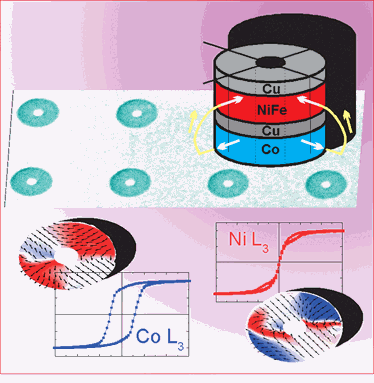The logic of computers is fairly simple. Even when solving the most complex analytical problems, computers need only two different states: “0” and “1.” The physical realization of such binary logic, however, can be very tricky. In the early days of computers, vacuum tubes were used, later to be superseded by solid-state semiconductor devices such as transistors. But all of those applications have a critical drawback. They use electrical charge to generate the 0 and 1 information. Thus, the main memory of a computer is extremely vulnerable to power outages. In addition, the energy consumption of a computer as it generates and conserves the charged/uncharged information states is unnecessary high.
A new and extremely promising path for the realization of computer logic is the use of the magnetic state of small, nanoscale-size magnets. As in macroscopic bar magnets, the orientation of the magnetic north and south poles can be used to generate two states. However, as we well know from our daily experience, two conventional bar magnets repel or attract each other, thanks to the magnetic stray fields of the poles. This type of cross-talk between single, magnetic-memory elements considerably limits the miniaturization of potential applications. Using magnetic rings instead of bar magnets can circumvent this problem. These rings exhibit a magnetic vortex state characterized by a flux-closure magnetization with zero stray fields where the chirality (the structural characteristic of a molecule that makes it impossible to superimpose it on its mirror image) of the magnetic flux, either clockwise or counterclockwise, represents a 0 or 1 state. There is a worldwide effort to utilize such ring structures for the development of novel computer-memory applications, such as magnetic random-access memories. These applications will consist of multilayers of magnetic and nonmagnetic materials. Most of the research so far, however, has focused on single-layer rings, due to the lack of powerful research tools that allow for layer-resolved studies.
The Argonne Advanced Photon Source (APS) is the type of powerful research tool needed to answer these kinds of questions. Scientists from Argonne, the University of Illinois at Chicago, and Cornell University, using the X-ray Operations and Research beamline 4-ID-C at the APS, and the Argonne Center for Nanoscale Materials, have demonstrated in the cover story of the 24 September 2007 issue of Applied Physics Letters that the interpretation of magnetic reversals cannot be easily transferred from the established knowledge in single-layer rings to multilayer-type structures. The group showed that in individual layers in thin rings, which alternate magnetic and nonmagnetic materials (NiFe/Cu/Co), layer-resolved hysteresis loops, measured using x-ray resonant magnetic scattering, exhibit the characteristics of a vortex formation, although photoelectron emission microscopy and micromagnetic simulations clearly prove that multi-domain states are formed. This result is of considerable importance for the development of pseudo-spin-valve-type structures for applications where a vortex formation is desired. The appearance of conventional, macroscopic magnetization measurements may be deceptive, and does not always show the suppression of vortex formation, which constrains the use of multilayer ring structures for memories.
Contact: Volker Rose, [email protected]
See: V. Rose, X.M. Cheng, D.J. Keavney, J.W. Freeland, K.S. Buchanan, B. Ilic, and V. Metlushko, “The breakdown of the fingerprinting of vortices by hysteresis loops in circular multilayer ring arrays,” Appl. Phys. Lett. *91*, 132501 (24 September2007). DOI: 10.1063/1.2786856
Use of the Advanced Photon Source is supported by the U.S. Department of Energy, Office of Science, Office of Basic Energy Sciences, under Contract No. DE-AC02-06CH11357.
Argonne is a U.S. Department of Energy laboratory managed by UChicago Argonne, LLC

